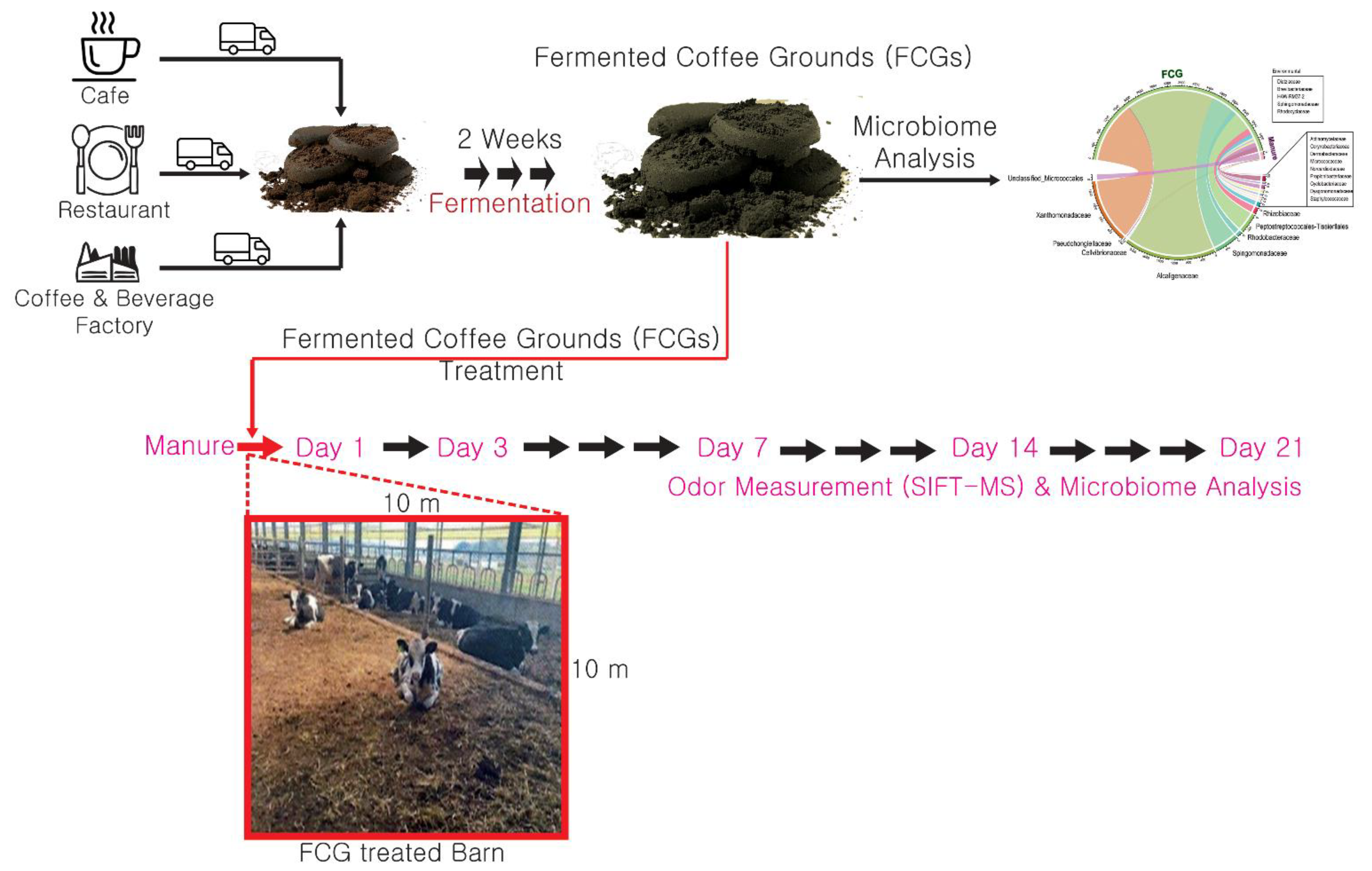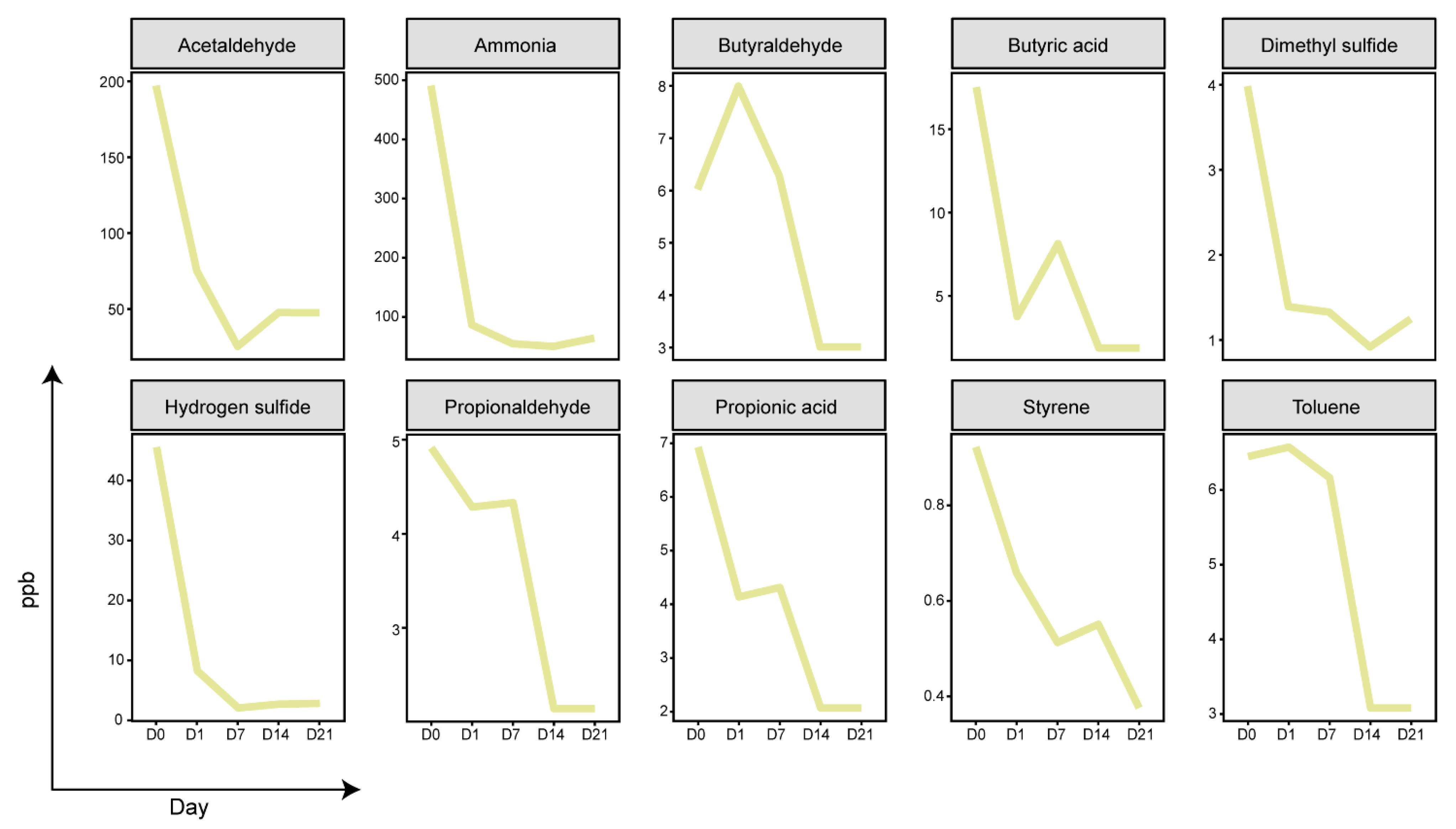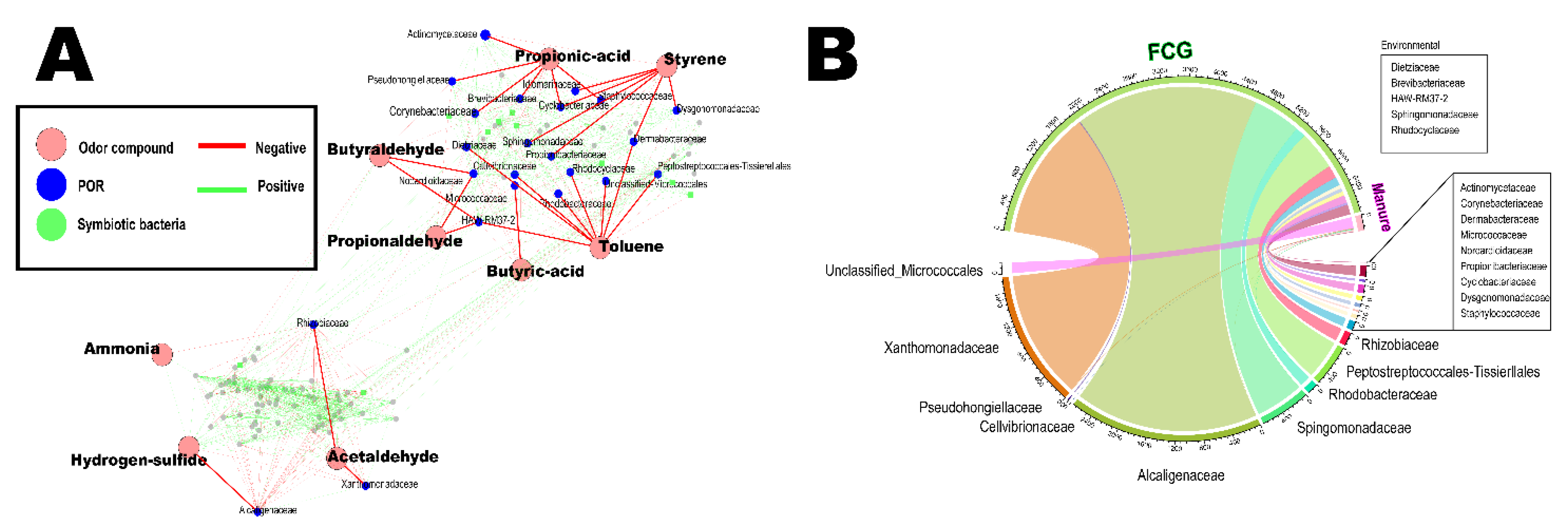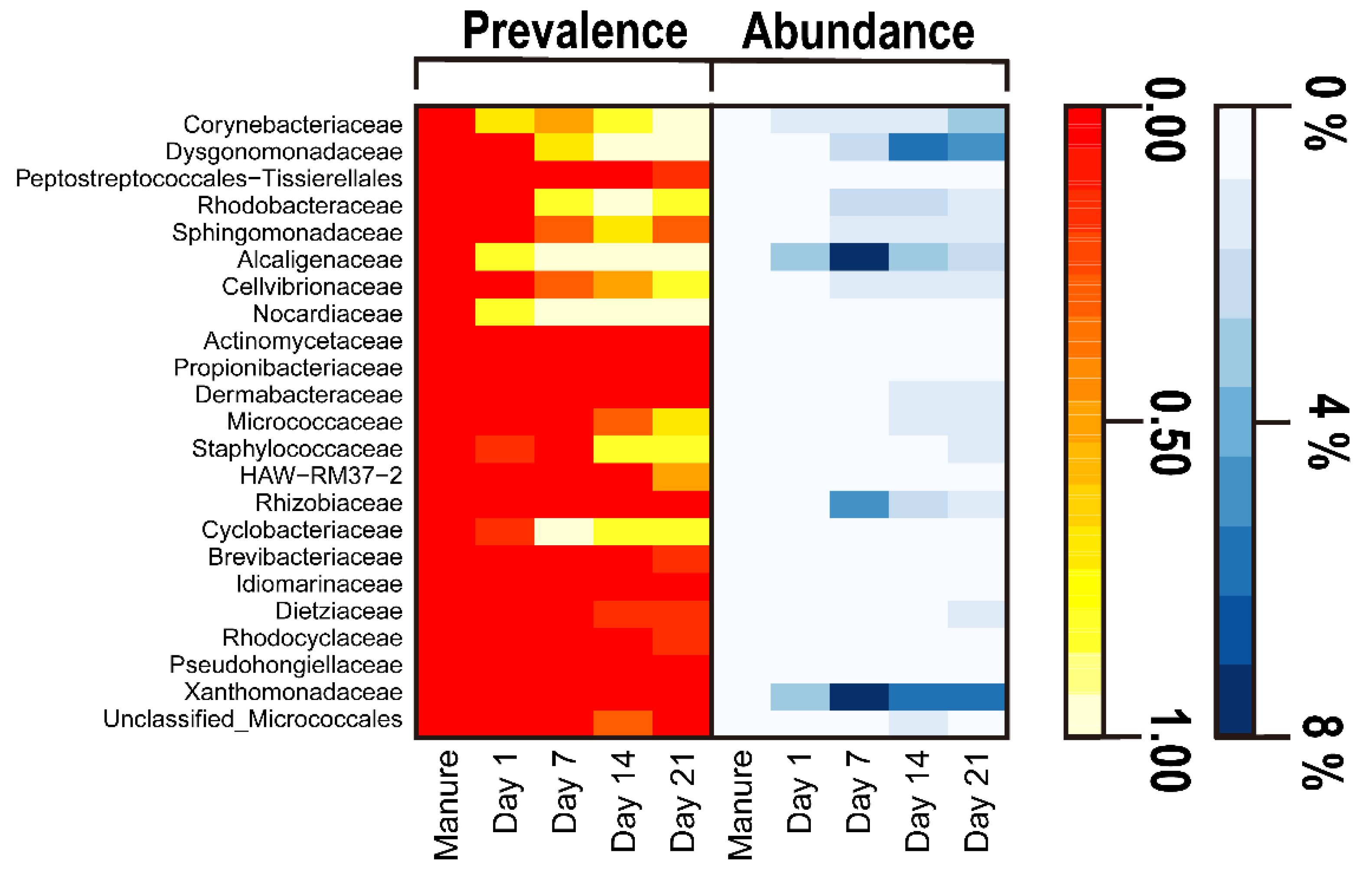Fermented Coffee Grounds Diminish Livestock Odors: A Microbiome Study
Abstract
1. Introduction
2. Materials and Methods
2.1. Study Design and Field Testing
2.2. Odor Measurement and Sampling
2.3. DNA Extraction
2.4. Library Preparation and High Throughput Sequencing
2.5. Bioinformatical Analysis
2.6. Statistical Analysis
3. Results
3.1. Overview of Odor Reduction
3.2. Microbial Shift after the Treatment
3.3. Alteration of Alpha Diversity and Core Bacteria
3.4. Selection of Potential Odor Reducers
3.5. Alteration of PORs after the Treatment
4. Discussion
5. Conclusions
Supplementary Materials
Author Contributions
Funding
Data Availability Statement
Conflicts of Interest
References
- Hooiveld, M.; Dijk, C. Odour annoyance in the neighbourhood of livestock farming perceived health and health care seeking behaviour. AAEM 2015, 22, 55–61. [Google Scholar] [CrossRef] [PubMed][Green Version]
- Mielcarek, P.; Rzeźnik, W. Odor emission factors from livestock production. Pol. J. Environ. Stud. 2015, 24, 27–35. [Google Scholar] [CrossRef]
- Schiffman, S.S. Livestock odors implications for human health and well-being. J. Anim. Sci. 1998, 76, 1343–1355. [Google Scholar] [CrossRef] [PubMed]
- Naseem, S.; King, A.J. Ammonia production in poultry houses can affect health of humans, birds, and the environment-techniques for its reduction during poultry production. ESPR 2018, 25, 15269–15293. [Google Scholar] [CrossRef] [PubMed]
- Ren, B.; Zhao, Y. Current Status and Outlook of Odor Removal Technologies in Wastewater Treatment Plant. Waste Biomass Valorization 2019, 10, 1443–1458. [Google Scholar] [CrossRef]
- Yasuda, T.; Waki, M. Characterization of the denitrifying bacterial community in a full-scale rockwool biofilter for compost waste-gas treatment. Appl. Microbiol. Biotechnol. 2017, 101, 6779–6792. [Google Scholar] [CrossRef] [PubMed]
- Haosagul, S.; Prommeenate, P. Sulfide-oxidizing bacteria community in full-scale bioscrubber treating H2S in biogas from swine anaerobic digester. Renew. Energy 2020, 150, 973–980. [Google Scholar] [CrossRef]
- Bardi, M.J.; Rad, H.A. Simultaneous synergistic effects of addition of agro-based adsorbent on anaerobic co-digestion of food waste and sewage sludge. J. Mater. Cycles Waste Manag. 2020, 22, 65–79. [Google Scholar] [CrossRef]
- Beniche, I.; Hungría, J. Effects of C/N ratio on anaerobic co-digestion of cabbage, cauliflower, and restaurant food waste. Biomass Conv. Bioref. 2021, 11, 2133–2145. [Google Scholar] [CrossRef]
- Elsayed, M.; Diab, A. Methane production from anaerobic co-digestion of sludge with fruit and vegetable wastes: Effect of mixing ratio and inoculumn type. Biomass Conv. 2021, 11, 989–998. [Google Scholar] [CrossRef]
- McNutt, J.; He, Q. Spent coffee grounds: A review on current utilization. J. Ind. Eng. Chem. 2019, 71, 78–88. [Google Scholar] [CrossRef]
- Garcia, C.V.; Kim, Y.T. Spent Coffee Grounds and Coffee Silverskin as Potential Materials for Packaging: A Review. J. Polym. Environ. 2021, 29, 2372–2384. [Google Scholar] [CrossRef]
- Korea Meteorlogical Administration. Available online: https://www.kma.go.kr/eng/index.jsp (accessed on 18 August 2021).
- Kang, G.U.; Ibal, J.C. Alteration of the soil microbiota in ginseng rusty roots: Application of machine learning algorithm to explore potential biomarkers for diagnostic and predictive analytics. J. Agric. Food Chem. 2021, 69, 8298–8306. [Google Scholar] [CrossRef] [PubMed]
- Bolyen, E.; Rideout, J.R. Reproducible, interactive, scalable and extensible microbiome data science using QIIME2. Nat. Biotechnol. 2019, 37, 852–857. [Google Scholar] [CrossRef]
- Callahan, B.J.; McMurdie, P.J. DADA2: High-resolution sample inference from Illumina amplicon data. Nat. Methods 2016, 13, 581–583. [Google Scholar] [CrossRef]
- Bokulich, N.A.; Kaehler, B.D. Optimizing taxonomic classification of marker-gene amplicon sequences with QIIME 2’s q2-feature-classifier plugin. Microbiome 2018, 6, 90. [Google Scholar] [CrossRef]
- Dixon, P. VEGAN, a package of R functions for community ecology. Appl. Veg. Sci. 2003, 14, 927–930. [Google Scholar] [CrossRef]
- Bioconductor (2012–2019). Available online: https://bioconductor.org/packages/release/bioc/html/microbiome.html (accessed on 1 August 2021).
- Raes, J.; Faust, K. CoNet app: Inference of biological association networks using Cytoscape. Food Res. 2019, 5, 1519. [Google Scholar]
- Wickham, H. ggplot2. Comput. Stat. Data Anal. 2011, 3, 180–185. [Google Scholar] [CrossRef]
- Gu, Z.; Gu, L. Circlize implements and enhances circular visualization in R. Bioinformatics 2014, 19, 2811–2812. [Google Scholar] [CrossRef]
- rdrr.io. Available online: https://rdrr.io/cran/gplots/ (accessed on 28 November 2020).
- Ministery of Environment. Available online: https://www.keco.or.kr/en/main/index.do (accessed on 1 August 2021).
- Park, J.; Kang, T. Evaluation of short-term exposure levels on ammonia and hydrogen sulfide during manure-handling process at livestock farms. Saf. Health Work 2020, 11, 109–117. [Google Scholar] [CrossRef] [PubMed]
- Kuruti, K.; Nakkasunchi, S. Rapid generation of volatile fatty acids (VFA) through anaerobic acidification of livestock organic waste at low hydraulic residence time (HRT). Bioresour. Technol. 2017, 2389, 188–193. [Google Scholar] [CrossRef]
- Liu, W.C.; Ye, M. Application of complex probiotics in swine nutrition—a review. Ann. Anim. Sci. 2017, 18, 335–350. [Google Scholar] [CrossRef]
- Mahardhika, B.P.; Mutia, R. Efforts to reduce ammonia gas in broiler chicken litter with the use of probiotics. IOP Conf. Ser. Earth Environ. Sci. 2019, 399, 012012. [Google Scholar] [CrossRef]
- Rybakova, D.; Berg, G. Microbiome definition re-visited: Old concepts and new challenges. Microbiome 2020, 8, 103. [Google Scholar]
- Dennehy, C.; Lawlor, P.G. Anaerobic co-digestion of pig manure and food waste; effects on digestate biosafety, dewaterability, and microbial community dynamics. Water Manag. 2018, 71, 532–541. [Google Scholar] [CrossRef]
- Shade, A.; Jones, S.E. Conditionally rare taxa disproportionately contribute to temporal changes in microbial diversity. mBio 2014, 4, e01371-14. [Google Scholar] [CrossRef]
- Kellermayer, R.; Nagy-Szakal, D. Serial Fecal Microbiota Transplantation Alters Mucosal Gene Expression in Pediatric Ulcerative Colitis. Am. J. Gastroenterol. 2015, 110, 604–606. [Google Scholar] [CrossRef]
- Li, F.; Yu, H. The quality of compost was improved by low concentrations of fulvic acid owing to its optimization of the exceptional microbial structure. Bioresour. Technol. 2021, 342, 125843. [Google Scholar] [CrossRef]






Publisher’s Note: MDPI stays neutral with regard to jurisdictional claims in published maps and institutional affiliations. |
© 2021 by the authors. Licensee MDPI, Basel, Switzerland. This article is an open access article distributed under the terms and conditions of the Creative Commons Attribution (CC BY) license (https://creativecommons.org/licenses/by/4.0/).
Share and Cite
Kim, M.-S.; Kim, S.-H.; Jeong, M.; Park, M.-K.; Jo, Y.; Kang, G.-U.; Jung, D.-R.; Lee, C.-I.; Shin, J.-H. Fermented Coffee Grounds Diminish Livestock Odors: A Microbiome Study. Agronomy 2021, 11, 1914. https://doi.org/10.3390/agronomy11101914
Kim M-S, Kim S-H, Jeong M, Park M-K, Jo Y, Kang G-U, Jung D-R, Lee C-I, Shin J-H. Fermented Coffee Grounds Diminish Livestock Odors: A Microbiome Study. Agronomy. 2021; 11(10):1914. https://doi.org/10.3390/agronomy11101914
Chicago/Turabian StyleKim, Min-Sueng, Sang-Ho Kim, Minsoo Jeong, Min-Kyu Park, YoungJae Jo, GI-Ung Kang, Da-Ryung Jung, Chang-Il Lee, and Jae-Ho Shin. 2021. "Fermented Coffee Grounds Diminish Livestock Odors: A Microbiome Study" Agronomy 11, no. 10: 1914. https://doi.org/10.3390/agronomy11101914
APA StyleKim, M.-S., Kim, S.-H., Jeong, M., Park, M.-K., Jo, Y., Kang, G.-U., Jung, D.-R., Lee, C.-I., & Shin, J.-H. (2021). Fermented Coffee Grounds Diminish Livestock Odors: A Microbiome Study. Agronomy, 11(10), 1914. https://doi.org/10.3390/agronomy11101914





